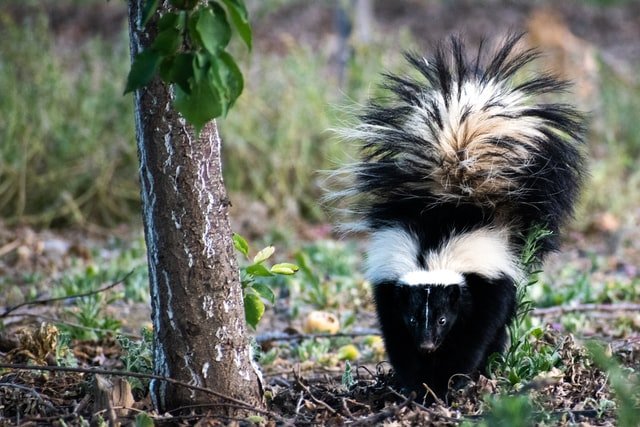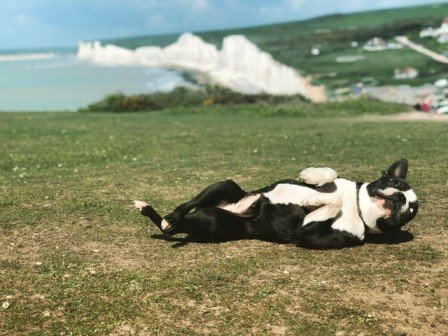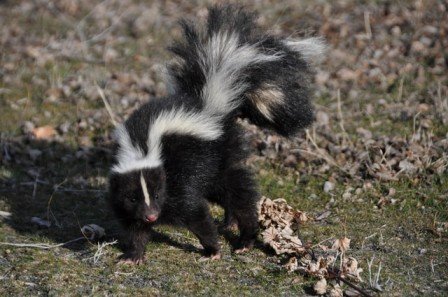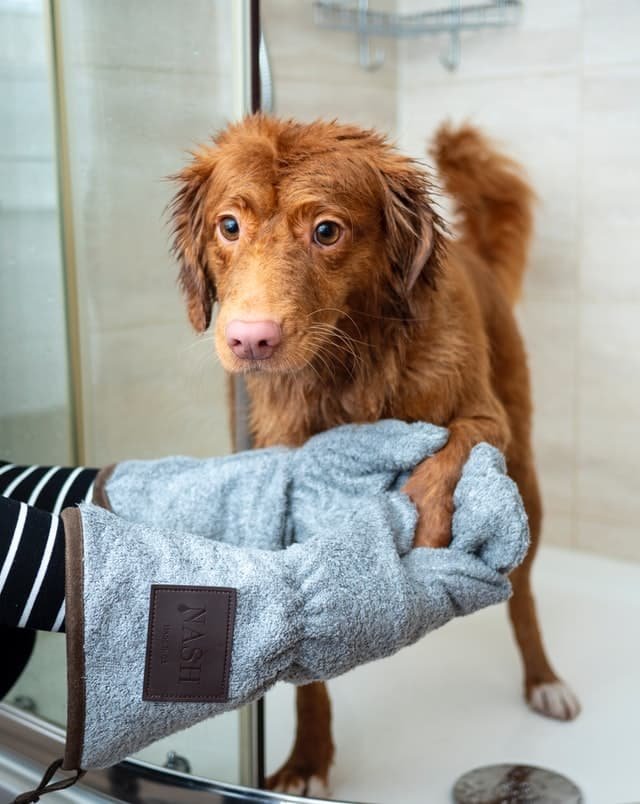Dogs are curious creatures. And if your dog has a strong prey drive, it will readily pursue smaller animals, even just for the pleasure of it. If your dog comes home sprayed by a skunk, your furry friend could be looking at some unusually stinky trouble.
Skunks are naturally non-aggressive and will prefer escaping over fighting. However, if they feel threatened, they will keep the predator at bay by spraying a foul-smelling substance.
A skunked dog is a foul-smelling dog, which is why your pet will need immediate first aid care to get rid of the smell and avoid other irritations.
This article is a practical guide to de-skunking your dog after an encounter with a spraying skunk. Before telling you what to do if your dog gets skunked, we’ll explain why and how a skunk is able to spray your dog with the smelly substance. Savor the details in the rest of the article!
What is Skunk Spray?
Skunk spray is a yellow oily substance produced in the anal glands of a skunk and splashed on a predator as a defense mechanism. The spray contains thiols or sulfurous chemicals that readily mix with your dog’s skin proteins to cause a persistent foul smell. This stink is extremely difficult to get rid of.

Like all oils, skunk spray does not readily mix with water. Instead, water enhances the foul smell of a skunk spray. As such, a skunked dog is hard to clean and free from the stench.
However, this does not mean that skunk spray cannot be cleaned off your dog’s coat, but just that it’s not the easiest thing to do. We’ll tell you how to make this difficult task easier in a bit. But let’s first understand why skunks spray the smelly stuff on your dog in the first place.
Why do Skunks Spray?
Spraying is a skunk’s natural way to deter predators or people and animals that annoy them. It is important to note that skunks don’t spray their annoyers as a first defense mechanism. Instead, a skunk will first hiss, arch their tail over their body, or stamp their feet to warn an approaching enemy to keep off. If this does not deter the pursuing animal or human, then a skunk will proceed to spray.
Because skunks are naturally gentle and peaceful, they will only spray your dog if they feel threatened and scared. A skunk can splash its smelly oil as far as 15 feet away. What’s more, a threatened skunk can spray up to 5 times in one instance before needing to recharge the anal sac that contains the defense spray.
So, how do you know that your dog has had an unpleasant encounter with a skunk?
Signs your Dog has been sprayed by a skunk
The number one sign that a skunk has sprayed your dog is the foul smell and the yellow oil on your dog’s face and coat.
Other signs your dog has been skunked include:
- Irritated, red eyes (skunk spray mostly lands on the face of preying dog).
- Dog rolling on the ground in an attempt to get rid of skunk spray.
- Dog pawing its face.
- Drooling.
- Sneezing.
- Temporarily blurred vision.
- Vomiting.
Rarer skunk spray symptoms that may show days after the episode include:
- Fatigue and weakness.
- Brown or pale gums.

Watch your dog for a couple of days after the skunk spray to notice any of these symptoms, and consult your vet if the symptoms seem to be worsening.
From the preceding info, you probably wonder if skunks are common in your area and if you should be wary of a skunk spray on your dog. We have answers for you in the following section.
When and Where are Skunk Sprays Most Common?
According to the U.S. Fish & Wildlife Service, skunks are found everywhere in the United States. However they can be more common or rarer in some regions depending on the skunk species.
The most ubiquitous skunk species is the striped skunk. It can be found almost everywhere but is rarer in Utah and Nevada. Other species like the western spotted skunk can also be found in most states, while the eastern spotted skunks are common in Florida, Texas, and the Appalachian ridges.

As for the ‘when’ question, skunks are most common in the warmer months of the year. They are rarely spotted in the cold winter seasons as they stay in their dens to keep warm. During the spring and summer months, skunks will mostly be seen at dawn and dusk. They can sometimes also be spotted foraging for food at other hours of the day and night.
Skunks usually live in underground dens but can be seen in caves, tree stumps, rock or woodpiles. In urban settings, skunks can live in garden sheds or under decks and cottages.
Since it is clear that skunks can be found anywhere and your dog can easily encounter one. Knowing how to give first aid to your skunked dog is extremely important.
What to Do If My Dog is Sprayed by a Skunk?
If your dog gets skunked, you should offer first aid to de-skunk your dog following the 3 main steps below. Note that the de-skunking should be done outside to avoid spreading the foul smell into your home.

Assess your Dog
If your dog gets sprayed by a skunk, it is likely that it was pursuing a skunk or was involved in some direct encounter with the animal. As a result, you can expected to find skunk spray on your dog’s face, and that needs immediate attention.
Also, look for any signs that your dog may have been bitten or scratched by the skunk. Skunks are carriers of the rabies virus and can pass it to your dog. If there are bites or scratches, your dog should likely get treatment against rabies or other required care.
De-skunk your Dog’s Face
Since your dog is likely to experience more discomfort from skunk spray on the face, start the de-skunking process there.
Rinse your dog’s eyes with clean, cold water. Get rid of any skunk spray and control the irritation and redness of the eyes. You can also use a saline eye solution from your dog first aid kit to rinse your dog’s eyes.
Wipe the rest of the face with a towel, flashing a bit more water if needed. Do not use detergents or other solutions on your dog’s face.
Homemade or Commercial De-skunking formula
The first thing you should do when de-skunking your dog’s coat is to soak up the yellow oil. Use old clothes or a towel that you can throw away after. Soaking up the oil makes washing off the skunk spray and eliminating the smell easier.
The next thing is to bathe your dog using a skunk spray remover. You have two options here:
Use a commercial de-skunking Formula
Keeping a de-skunking formula in your dog first aid kit is a wise decision. Especially if you live in an area where skunks are common or often take your dog when you go hiking.
We recommend Nature’s Miracle Skunk Odor Remover from Amazon.com, which you can use on your dog and any contaminated clothing or surface. Opt for the original type as opposed to the scented varieties.
Use a homemade de-skunking formula
The most popular and effective homemade de-skunking formula is the hydrogen-baking soda-dishwashing liquid mixture. You can make it by mixing the 3 ingredients as indicated:
- One quart 3% hydrogen peroxide
- A ¼ cup of baking soda
- One teaspoon of dishwashing liquid
De-skunk your Dog’s Coat
Once your de-skunking solution is ready, proceed to bathe your dog following these steps:
- Wear a pair of protective gloves.
- Apply the hydrogen-baking soda-dishwashing liquid mixture you’ve just made on your dog’s coat. Then gently massage the mixture into your dog’s fur and skin,
- Allow the mixture to sit on your dog’s coat for about 10-20 minutes.
- Rinse your dog’s coat and skin thoroughly.
- Bathe the dog again with the usual pet shampoo.
- Repeat the entire process if the stench of the skunk spray is still detectable. Each time ensuring you thoroughly rinse the de-skunking solution and the shampoo from your dog’s coat.
- Towel dry your dog and allow him to rest.
The following caveats should be borne in mind when bathing your skunked dog with the hydrogen-baking soda-dishwashing liquid mixture:
- The mixture should be freshly made for the occasion.
- Do not store any remaining mixture in a closed container as it can explode.
- Be cautious not to get the mixture into the dog’s eyes or your own eyes.
- Do let the mixture sit for too long on your dog’s coat. Hydrogen peroxide can cause bleaching on your dog’s fur.
- Never use hydrogen peroxide with a higher than 3% concentration.
Also, you’ll need to wash any clothing you have used while bathing your dog to remove the skunk smell. Use your usual laundry detergent with a bit of baking soda. Alternatively, you can wear old clothes that you will dispose of when done, together with the gloves.
A mixture of vinegar and water is an alternative homemade remedy for de-skunking your dog. Some people also use tomato juice. However, none of these is as effective as the hydrogen-baking soda-dishwashing liquid mixture.
Can I Prevent My Dog from Being sprayed?
There are two things you can do to deter skunks and prevent your dog from being skunked:
First, if you notice skunks coming to your yard, the best way to keep your dog from them, is to deter the skunks. This can be done by eliminating any food sources for skunks in your compound, such as garbage bins. Also, fix, block, or destroy areas in your compound or yard where skunks can hide. This includes sheds, areas beneath porches or decks, piles of wood, or old tree stumps.
Second, if you live in wooden areas and are fond of taking walks in the woods with your dog, try to avoid dusk and dawn walks. These are the hours when skunks are most active.
Key Takeaways
A dog’s encounter with a skunk can leave your furry friend splashed with the foul-smelling skunk spray.
While skunk spray is hard to clean, there are commercial and homemade formulas that can make your dog’s de-skunking job easier. These include Nature’s Miracle Skunk Odor Remover, which you can keep in your dog first aid kit, and the homemade hydrogen-baking soda-dishwashing liquid remedy.
When offering first aid to a skunked dog, start first with the eyes and face to stop any irritation, then proceed to the coat and skin.
You can keep away skunks by eliminating any areas that can serve as a home for a skunk in your compound. If you live near the woods, avoid dusk and dawn walk with your dog.
